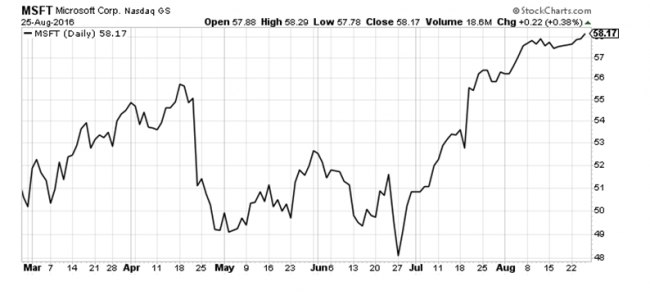Where can a yield-starved investor turn today without chasing dividends?
You may not be comfortable with the answer. In fact, I can practically guarantee that most people reading this article will not read past the next paragraph.
[ad#Google Adsense 336×280-IA]The mainstream financial press and investment services industry have done too good of a job scaring people about today’s topic.
I don’t stand much of a chance! But it’s my job to tell you exactly how I think you should be investing today – not to spoon-feed you what you want to hear.
So here goes:
I’m talking about covered calls. In order to take advantage of this options strategy, you do not – I repeat, DO NOT – need to trade options.
In fact, you can use this covered call strategy in a retirement account. Best of all, you can profit from this covered-call strategy using a regular old ETF.
But for some reason, self-directed investors seem to ignore what is, in my opinion, the best, and easiest, income strategy available to investors today.
The Time Has Come to Harness This Covered-Call Strategy
It’s truly time for the average investor to consider using covered calls.
But before I go into further details on how I use covered calls, let’s discuss a few basics.
What is a covered call?
Covered calls are an options strategy whereby an investor holds a long position in an asset and writes (sells) call options on that same asset in an attempt to generate increased income from the asset. The covered-call strategy is often employed when an investor has a short-term neutral-to-bearish view on the asset and for this reason decides to hold the asset (long) and simultaneously have a short position via the option to generate income from the option premium. Covered calls are also known as a “buy-write” strategy.
For example, let’s say that you own shares of Microsoft (NASDAQ: MSFT). You like the stock’s long-term prospects as well as its share price but feel in the shorter term the stock will likely trade relatively flat to lower, perhaps within a few dollars of its current price of, say, $58.

Take a look at the options chain for MSFT below. If you sell a call option on MSFT at the $60 call strike, you can earn the premium of roughly $1.07 from the option sale.

One of three scenarios is going to play out:
(a.) MSFT shares trade flat (below the $60 strike price) – the option will expire worthless and you keep the premium ($107 per contract sold) from the option. In this case, by using the covered call strategy you have successfully outperformed the stock. You’ve also locked in a return of roughly 1.8% over 57 days and you can repeat the process over and over into perpetuity.
(b.) MSFT shares fall – the option expires worthless, you keep the $107 premium, and you cover some of the downside risk associated with the decline in MSFT’s share price.
(c.) MSFT shares rise above $60 – the option is exercised, and your upside is capped at $60, plus the option premium. In this case, if the stock price goes higher than $61.07, your covered call strategy has underperformed MSFT shares over the short term, but you’ve locked in a healthy 5% return in less than 60 days.
As I have often stated, most investors think of options as high-risk, speculative strategies where large losses can be incurred. While this is certainly true of some options strategies, covered calls are actually more conservative than investing in ETFs or stocks alone.
In other words, a covered-call strategy is SAFER than buying a stock or an ETF. Why?
Because covered calls:
- Provide some protection in a down market
- Are one of the few ways an index investor can achieve double-digit returns in a flat or slow-growth market.
- Lower your cost basis while decreasing the volatility of your portfolio.
- Allow investors to bring in income on a consistent basis.
Remember, covered calls make money when stocks are slightly higher, flat or down. You only get the underlying stock “called” away if it rises significantly.
So again, why would any investor choose to shy away from such a proven income strategy that has outperformed the market and dividend-paying stocks over the long term?
— Andy Crowder
[ad#wyatt-generic]
Source: Wyatt Investment Research
